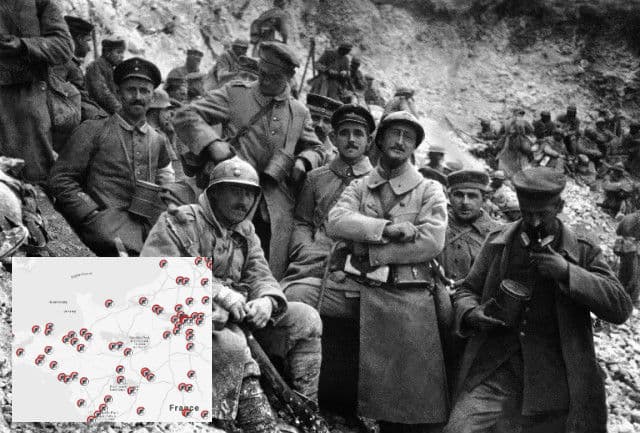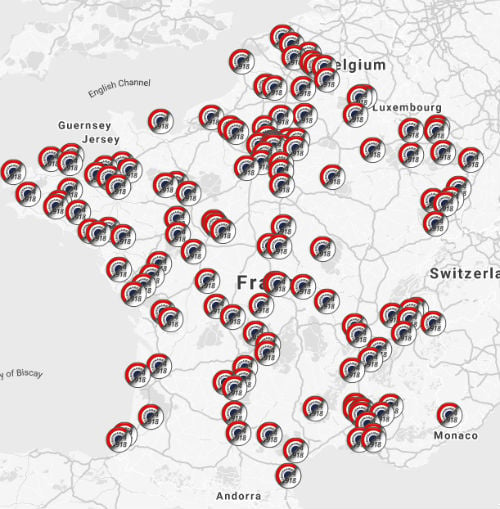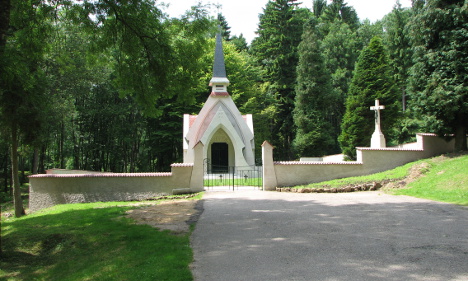Armistice Day: How France will commemorate 100 years since the end of WWI

This weekend events will be taking place across France to commemorate the 100th anniversary of the signing of the Armistice treaty that brought an end to World War One.
The biggest event will be the one at the Arc de Triomphe on the Champs-Elysees in Paris on Sunday which will be attended by up to 70 world leaders including US President Donald Trump and his Russian counterpart Vladimir Putin.
On Saturday afternoon Macron will meet German Chancellor Angela Merkel at Rethondes in the Compiegne Forest to the north of Paris where the Armistice was signed.
Sunday's ceremony at the Tomb of the Unknown Soldier on the Champs-Elysees avenue will take place at 11 am -- marking the time when the guns finally fell silent after four years of bloody trench warfare in France and Belgium. Macron will deliver a speech in front of world leaders.
Many of the invitees, including Putin, Turkey's Recep Tayyip Erdogan and Germany's Angela Merkel, are then expected to attend the opening of the inaugural Paris Peace Forum at La Villette in the 19th arrondissement, which French President Emmanuel Macron will host. Although Trump won't be there.
British Prime Minister Theresa May was also in France on Friday to commemorate the sacrifice of British soldiers in the First World War.
The commemoration, just ahead of the 100th anniversary of the end of WWI, was to be held at the Thiepval Memorial to the Missing of the Somme, in northern France, near the Belgian border.
There will also be events taking place across France (see map below) which can be found at the official centenary website.
READ ALSO:
 Map: Centenaire.org
Small ceremonies and remembrance parades will take place on November 11th in each village and town in the department of Somme, the location of the largest battle of World War One fought on the Western Front.
There will also be events held in other areas of military significance, such as Verdun where there will be church services and ceremonies in honour of the fallen.
Map: Centenaire.org
Small ceremonies and remembrance parades will take place on November 11th in each village and town in the department of Somme, the location of the largest battle of World War One fought on the Western Front.
There will also be events held in other areas of military significance, such as Verdun where there will be church services and ceremonies in honour of the fallen.
Like many other nations, France also marks the signing of the armistice with a minute of silence at exactly 11 am on November 11th each year, providing a moment to contemplate and remember those who served and lost their lives for their country, not just in the First World War but in other wars too.
In France, the bleuet or cornflower is used as a symbol of remembrance alongside the poppy, which is used in countries belonging to the Commonwealth of Nations.
The flower was chosen because cornflowers have traditionally symbolized "pure and delicate" sentiments, while blue is one of the colours of the French flag, and was also the colour of many soldiers' uniforms in the First World War.
Profits from the sale of cornflower brooches go to aid organisations assisting victims of war including veterans, orphans and widows.
Memorials
There are no living veterans of the First World War in France as the last surviving soldier, Claude Choules, passed away in 2011 having reached the age of 110. But in towns and villages across the country, people gather at memorials and battlefields to remember the sacrifices made by France's fighters.
For example, in Bastia in Corsica, the day is marked with singing, readings of soldiers' letters by local schoolchildren, and projections of archive footage.
The villages which 'died for France'

Bezonvaux church. Photo: TCY/Wikicommons
Several villages were razed to the ground in the battles which led to the end of the war. These include Beaumont-en-Verdunois, Bezonvaux, Cumières-le-Mort-Homme, Fleury-devant-Douaumont; Haumont-près-Samogneux and Louvemont-Côte-du-Poivre, all of which are located in the départment of Meuse.
Residents were evacuated at the start of the Battle of Verdun, which raged from February 21st to December 18th 1916, but when they returned they found that everything had been destroyed in the conflict, from houses and buildings to trees and hedges.
In 1919, the land was bought by the government and it was decided that the six villages would not be rebuilt or inhabited, but would remain as memorials, each with a mayor and an annual budget to take care of the land.
Restoration of graves
Memorial group Le Souvenir Français is campaigning for graves of soldiers to be restored.
The First World War was the first time soldiers killed in combat were buried in individual tombs rather than in mass graves; each tomb was marked with the words 'Mort pour la France' (Died for France). The 265 military cemeteries around the country contain the remains of around 740,000 soldiers, but Le Souvenir Français says many of these graves are falling into disrepair and wants to protect them.
Comments
See Also
 Map: Centenaire.org
Map: Centenaire.orgLike many other nations, France also marks the signing of the armistice with a minute of silence at exactly 11 am on November 11th each year, providing a moment to contemplate and remember those who served and lost their lives for their country, not just in the First World War but in other wars too.
Memorials
There are no living veterans of the First World War in France as the last surviving soldier, Claude Choules, passed away in 2011 having reached the age of 110. But in towns and villages across the country, people gather at memorials and battlefields to remember the sacrifices made by France's fighters.
For example, in Bastia in Corsica, the day is marked with singing, readings of soldiers' letters by local schoolchildren, and projections of archive footage.
The villages which 'died for France'

Bezonvaux church. Photo: TCY/Wikicommons
Several villages were razed to the ground in the battles which led to the end of the war. These include Beaumont-en-Verdunois, Bezonvaux, Cumières-le-Mort-Homme, Fleury-devant-Douaumont; Haumont-près-Samogneux and Louvemont-Côte-du-Poivre, all of which are located in the départment of Meuse.
Residents were evacuated at the start of the Battle of Verdun, which raged from February 21st to December 18th 1916, but when they returned they found that everything had been destroyed in the conflict, from houses and buildings to trees and hedges.
In 1919, the land was bought by the government and it was decided that the six villages would not be rebuilt or inhabited, but would remain as memorials, each with a mayor and an annual budget to take care of the land.
Restoration of graves
Memorial group Le Souvenir Français is campaigning for graves of soldiers to be restored.
The First World War was the first time soldiers killed in combat were buried in individual tombs rather than in mass graves; each tomb was marked with the words 'Mort pour la France' (Died for France). The 265 military cemeteries around the country contain the remains of around 740,000 soldiers, but Le Souvenir Français says many of these graves are falling into disrepair and wants to protect them.
Join the conversation in our comments section below. Share your own views and experience and if you have a question or suggestion for our journalists then email us at [email protected].
Please keep comments civil, constructive and on topic – and make sure to read our terms of use before getting involved.
Please log in here to leave a comment.